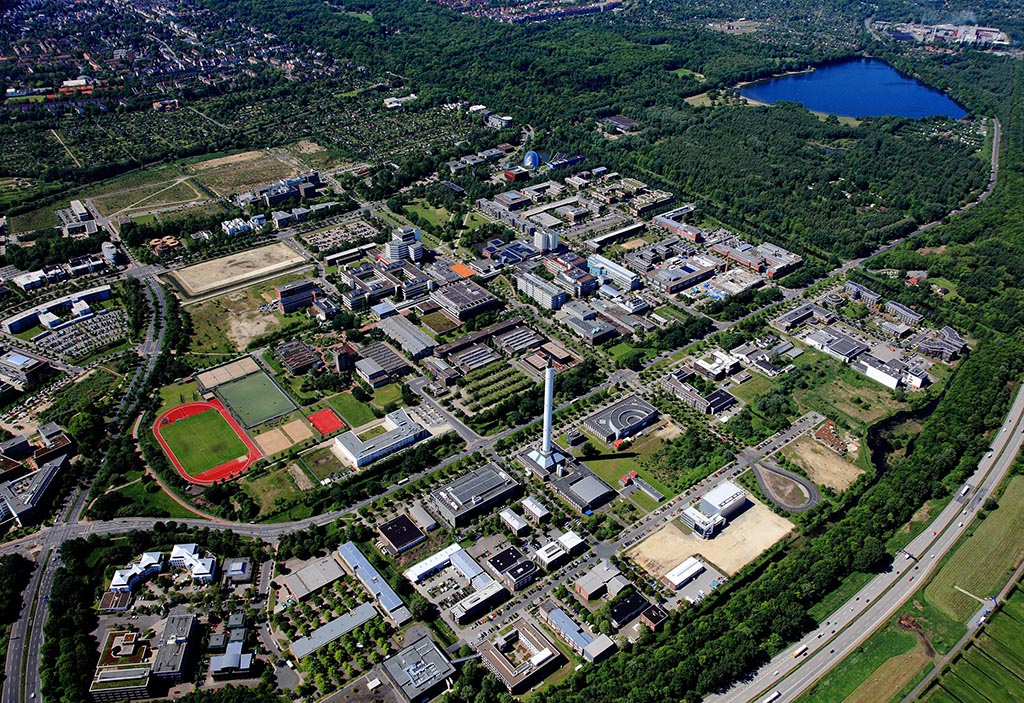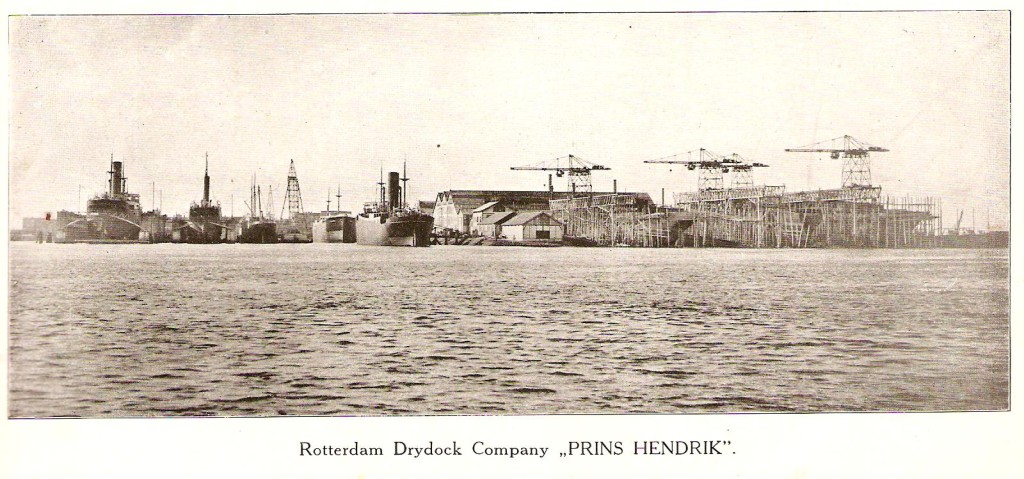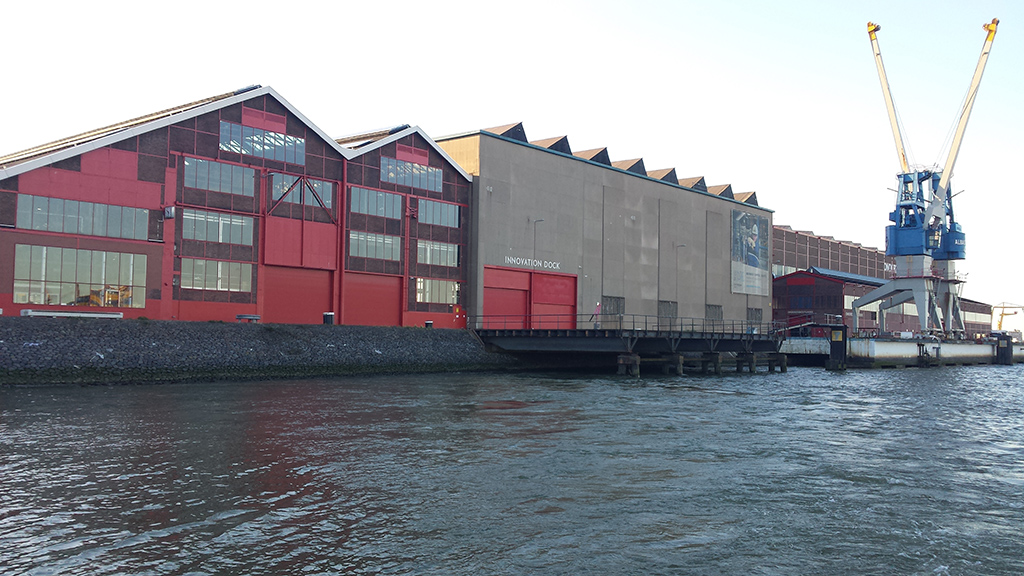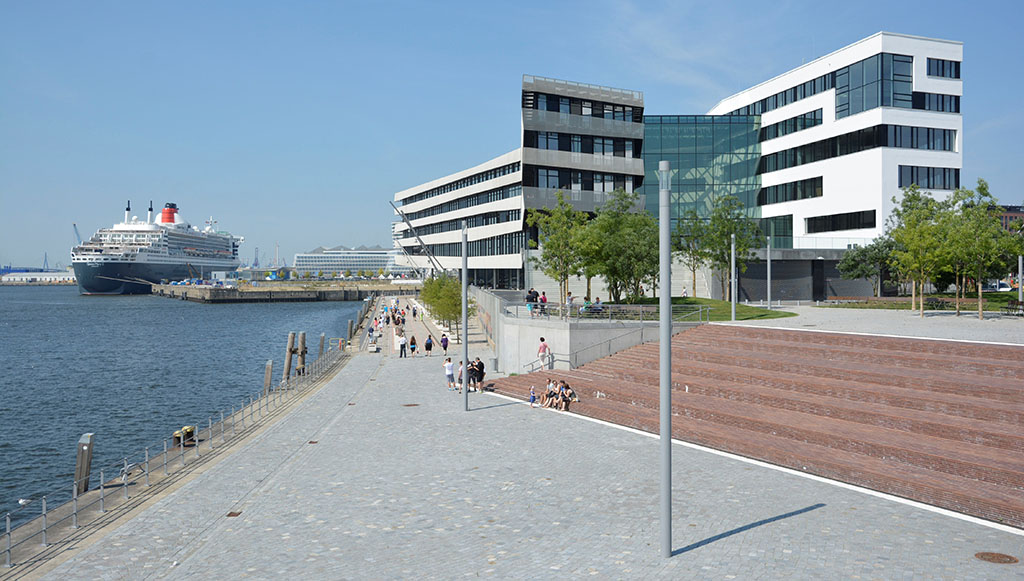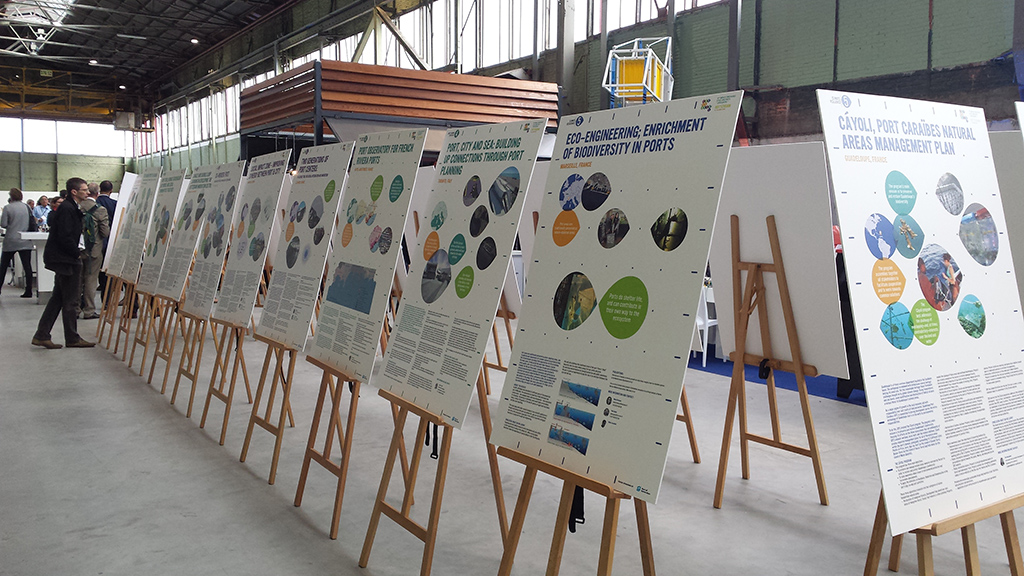In 1911, under the aegis of Hamburg’s General Lecture system, an academic lecture hall was inaugurated on Edmund Siemers Allee, a boulevard named after a local merchant who sponsored the building. Despite public opposition to the creation of a university on the grounds that the city was primarily a mercantile center [1], some academic institutions were founded in the first decade of the 20th century, including the Hamburg Science Foundation and the Hamburg Colonial Institute, both having links to overseas operations. Public opinion seems to have considered academia a stumbling block rather than an opportunity. And it would take eight more years, until 1919, and the continuous efforts of senator and subsequently mayor Werner von Melle to promote the consolidation of the these and other academic institutions in the city and to push through the official creation of the University of Hamburg.
Aerial view of the Bremen University campus with the famous “Fallturm” or drop tower where weightlessness can be briefly produced. (Source: Universitaet Bremen)
Rather than being an exception, this story is similar to those of other major port cities that are primarily trading centers and not capital cities. The citizens of many port cities seem to have assumed that students should attend the leading university elsewhere in their particular field of study. When these port cities established universities, most focused on global networks and trade, as befit them. Several major Northern European port cities make striking examples. Rotterdam’s citizenry supported the creation of the Nederlandsche Handelshoogschool (Netherlands School of Commerce) as late as 1913. After several name changes and the expansion of disciplines, it was absorbed by the Erasmus University Rotterdam, which opened its doors in 1973. [2] In the true spirit of a merchant city, it was named after the philosopher Erasmus (1466–1536), who coined the adage that became the university’s motto: “All the World is your Fatherland (Heel de wereld is je vaderland).” Bremen opened the doors of its university even later. Planned from 1966 on the outskirts of the city, it opened in 1971. [3] Under the dictum “Focus on the World (Die Welt fest im Blick),” the young university today positions itself in a global context. The University of Antwerp, with roots in earlier institutions such as the Institut Supérieur de Commerce de l’État created in 1852, was not inaugurated until 2003. Questions of management and maritime transport and law play an important role in the university, again a field closely connected to the mercantile role of a port. [4]
Whether this tendency to delay the founding of universities is only typical of a few Northern European port cities, or a more pervasive phenomenon is a question deserving further research. Counter-examples from Southern Europe come to mind, but these are the result of royal or papal patronage rather than civic and mercantile determination. Universities founded in Naples (1224), Barcelona (1450), and Genova (1471) have century-long histories as centers of learning. [5] They owe their foundation to Frederick II, Emperor of the Holy Roman Empire in Naples, King Alfonso V in Barcelona, and Pope Sixtus IV for the creation of the College of Theology in Genova. This raises the question of the role of the university in relation to the larger goals and economic forces at work in the civic domain of the municipality and the port as an industry.
Photo of the Rotterdam Drydock Company in 1918. (Source: G. Dirkswager M. Zoon’s Guide to the New-Waterway for 1918 forty-fourth year printed and published since 1874 by G.B. ‘t Hooft, Rotterdam)
The RDM Campus in Rotterdam. (Source: AIVP)
In the last decade, the answer seems to be that academic institutions can be instrumental in urban development, notably in disused waterfront districts. Following containerization and the abandonment of inner-city ports over the world, cities have developed diverse strategies for their waterfronts. As part of the construction of the multi-functional HafenCity, Europe’s largest urban renewal project, the City of Hamburg has brought together departments devoted to architecture and urban planning representing three universities to create the HafenCity University. This first university of the built environment is located in the new multi-functional district situated on abandoned port land. In Rotterdam, with the decline in shipbuilding activities and increased production in Asia, the former wharf of the Rotterdam Drydock Company (RDM) came into the hands of the municipality. Today, the RDM facilities have been preserved and rededicated to business, educational institutions, and diverse events. Academic institutions have thus become a way for local municipalities to fill the gaps left behind by the departure of the port.
The new building of the HafenCity University on the waterfront in Hamburg. (Source: ELBE&FLUT; HafenCity Hamburg GmbH)
But, rather than being a spatial filler after the departure of the port, can universities through their research and education, develop a position as agents capable of mediating between port and city? Could the dialogue between logistics and transportation that determines the relationship between port and city benefit from input from the humanities and social sciences? Municipal leaders and port authorities ostensibly seek ways to bring port and city into a rapport – at least that was a goal expressed at the recent Crossovers conference of the AIVP held at the RDM campus in Rotterdam. Discussions at the conference focused on the search for a new model for the City Port economy of the future, focusing on themes such as circular economy, innovative business, smart technologies, joint planning strategies, climate resilience, and social innovation. Many of these questions are also being discussed in universities, which are often publicly founded. But most of the collaboration between ports and universities has focused on technical and economic issues relating to the port as a machine that functions independently of the urban dynamics of the city. Including the humanities and social sciences in ongoing discussions about the future of the port city may help in the development of the form, function, and culture of port cities that are socially just, environmentally sound, and economically viable at a time of migration and the rapid transformation of port cities as innovation hubs now and in the future.
The “Crossover” event of the AIVP in October 2016 at the RDM campus in Rotterdam. (Source: AIVP)
Notes
[1] Universität Hamburg, Geschichte der Universität (https://www.uni-hamburg.de/uhh/profil/geschichte.html)
[2] Erasmus University Rotterdam, History (https://www.eur.nl/eur/historie/), https://www.eur.nl/english/eur/background/
[3] Universität Bremen, History https://www.uni-bremen.de/en/university/profile/history.html
[4] Universiteit Antwerpen, History of the University of Antwerp, https://www.uantwerpen.be/en/about-uantwerp/facts-figures/history/
[5] Università degli Studi di Napoli, Federico II, L’Università degli Studi di Napoli Federico II, https://www.unina.it/chi-siamo/cenni-storici; Universitat de Barcelona, The University of Barcelona: 564 years of history, https://www.ub.edu/web/ub/en/universitat/coneix_la_ub/historia/Historia.html; Università degli Studi di Genova, Brief history, https://www.unige.it/storia/
Head image: Main building of the University of Hamburg on Edmund Siemers Allee. (Source: UHH/Dichant)
